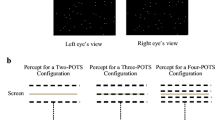Abstract
Measuring local Stereopsis by means of random dot stereograms with increasing horizontal disparity, the relative density of binocular cortical projection has been determined at a distance of 75 min of arc from the fovea. The accuracy of stereoscopic perception decreased with increasing horizontal disparity. The reciprocal value of the error frequency was used to measure the denisty of binocular cortical projection. Panum's area at the above mentioned distance from the fovea can be constructed by plotting the error frequency against the horizontal disparity. We observed a decrease of the relative density of binocular cortical projection towards the limits of Panum's area without a sharp break. The results are in agreement with those reported by Bishop and Henry and Joshua in the cat (receptive field disparity). The theory of stereopsis as proposed by Bishop explains our findings well and may be transferred to bincoular vision in man.
Zusammenfassung
Mit Hilfe von Random-dot-Stereotests zunehmender Querdisparation wurde die relative Dichte der kortikalen binokularen Stereoprojektion in einem Abstand von ca. 75 Bogenminuten von der Fovea am Menschen bestimmt. Mit zunehmender Querdisparation sank die Präzision der stereoskopischen Erkennbarkeit. Aus dem Logarithmus des Kehrwertes der Fehlerzahl, der als Maß für die relative Dichte der stereoskopischen binokularen Projektion gewertet wird, läßt sich durch Auftragen gegen die Querdisparation das Panumareal für die beschriebene Entfernung von der Fovea konstruieren. Die relative Dichte der binokularen Stereoprojektion innerhalb des Panumareals nimmt zum Rand hin langsam ab, ohne einen scharfen Abbruch zu zeigen. Die Ergebnisse stimmen sehr gut mit denen überein, die Bishop sowie Henry und Joshua an Katzen gemessen haben (Streuung rezeptiver Felder). Die Theorie der Stereopsis, wie sie von Bishop formuliert wurde, erklärt diese Befunde ausgezeichnet und kann offenbar auf den Menschen übertragen werden.
Similar content being viewed by others
Literatur
Bishop, P.O.: Neurophysiology of binocular vision and stereopsis. Handbook of sensory physiology Vol. VII/3 Part A 255–305 Hrsg. Jung. Berlin-Heidelberg-New York: Springer 1973
Bishop, P.O.: Binocular vision in Adler's Physiology of the eye. Sixth Edition p. 558–614. Louis: Mosby St. 1975
Crone, R.A.: The kinetic and static function of binocular disparity. Motor function at constant disparity. Invest. Ophthal. 8, 557–560 (1969)
de Decker, W., Scheffel, Th.: Simultaneous investigation of fixation disparity, stereothreshold and horopter balance. Albrecht v. Graefes Arch. klin. exp. Ophthal. 207, 97–109 (1978)
Friedburg, D.: Was ist anomale Netzhautkorrespondenz? — Versuch einer neurophysiologischen Erklärung. Ber. 133. Vers. Rhein. Westf. Augenärzte 19–24 (1977)
Friedburg, D.: Ist Fixationsdisparität der Motor der Fusion? Ber. Dtsch. Ophthal. Ges. 75, 473–475 (1978)
Friedburg, D.: A new concept of anomalous correspondence. 4th. International Orthoptic Congress Bern (1979) (in press)
Henry, G.H., Bishop, P.O., Coombs, J.S.: Inhibitory and subliminal excitatory receptive fields of simple units in cat striate cortex Vision Res. 9, 1289–1296 (1969)
Joshua, D.E., Bishop, P.O.: Binocular single vision and depth discrimination. Receptive field disparities for central and peripheral vision and binocular interaction on peripheral single units in cat striate cortex. Exp. Brain Res. 10, 389–416 (1970)
Julesz, B.: Binocular depth perception without familiarity cues. Science 145, 356–362 (1964)
Monjé, M., Stingl, H., de Decker, W.: Fixationsdisparität bei peripherem und zentralem Binokularsehen unter phorischer Belastung. Albrecht v. Graefes Arch. klin. exp. Ophthal. 194, 95–107 (1975)
Ogle, K.N., Mussey, F., Prangen, A.: Fixation disparity and the fusional process in binocular single vision. Amer. G. Ophthal. 32, 1069–1087 (1949)
Panum, P.L.: Physiologische Untersuchungen über das Sehen mit zwei Augen. Kiel: Schwerssche Buchhandlung 1858
Poggio, G.F., Fischer, B.: Binocular interaction and depth sensitivity in striate and prestriate cortex of behaving Rhesus Monkly. J. of Neurophysiol. 40, 1392–1405 (1977)
Uttal, W.R., Fitzgerald, J., Askin, Th.E.: Rotation and translation effects on stereoscopic acuity. Vision Res. 15, 939–944 (1978)
Author information
Authors and Affiliations
Additional information
Fräulein I. Meyer danke ich für ihre Mitarbeit bei der Durchführung der Versuche
Rights and permissions
About this article
Cite this article
Friedburg, D. Abnehmende lokale Stereopsis mit zunehmender Querdisparation, ein Hinweis auf abnehmende Dichte der binokularen Projektion am Rande des Panumareals. Albrecht von Graefes Arch. Klin. Ophthalmol. 213, 109–114 (1980). https://doi.org/10.1007/BF00413537
Received:
Issue Date:
DOI: https://doi.org/10.1007/BF00413537




